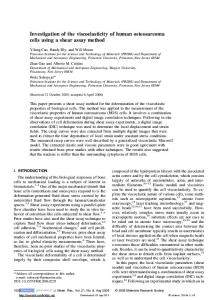A study on the boundary of linear viscoelasticity in simple shear flows: model calculations
- PDF / 2,266,741 Bytes
- 8 Pages / 595 x 842 pts (A4) Page_size
- 100 Downloads / 308 Views
www.springer.com/13367
A study on the boundary of linear viscoelasticity in simple shear flows: model calculations Taehoon Kim1, Junghaeng Lee1, Kwang Soo Cho1,*, Hye-Jin Ahn2 and Ki-Won Song2 Department of Polymer Science and Engineering, Kyungpook National University, Daegu 41566, Republic of Korea 2 Department of Organic Material Science and Engineering, Pusan National University, Busan 46241, Republic of Korea (Received February 3, 2020; final revision received May 8, 2020; accepted June 11, 2020) 1
Linear viscoelastic region is important to investigate material properties. We investigated boundary of linear viscoelasticity for simple shear flows with various time functions of shear strain. We used Phan-Thien and Tanner (PTT) model and Giesekus model in order to extract the linearity criterion. We determined critical strain (c) as a function of dimensionless number such as De or Wi and the nonlinear parameter of the models. We found a superposition of the critical strain at start-up shear flow and oscillatory shear flow. Replacing relaxation time by mean relaxation time ( J e o ) , we checked the validity of the equation with experimental data. Keywords: linear viscoelasticity, nonlinear viscoelastic model, simple shear flow, LAOS
1. Introduction Linear viscoelastic functions such as relaxation modulus, dynamic modulus and creep compliance have been used in many applications. However, each material function has its own merits and demerits Cho et al. (2017). Although measurement of relaxation modulus is faster than that of dynamic modulus, dynamic modulus is more accurately measured than relaxation modulus. Because of various reasons, one needs the conversion of the data of a viscoelastic function to those of others. Tassieri et al. (2016) invented one-step method to measure viscoelastic functions called i-rheo, which can do such things efficiently. Although i-rheo must be a wonderful methodology, it also needs to check the linear regime before input signal. Hence, one may think of the needs for a method to predict the boundary of linear viscoelasticity. To identify the boundary of linear viscoelasticity is also important in experiments of large amplitude oscillatory shear (LAOS) Hyun et al. 2011. If the input amplitude (usually strain amplitude) belongs to the linear regime then nonlinear response cannot be expected. Hence, if one can calculate the linear boundary from the information of linear viscoelasticity then experimental labor must be reduced. It is usual to use the strain sweep test in order to determine the linear boundary. However the linear boundary is dependent on frequency. It takes long time to determine the linear boundary for all frequencies under interest. The main purpose of this paper is to propose an empirical equation for the critical strain at which nonlinearity starts. The equation will be derived from the numerical data calculated from nonlinear viscoelastic models such as the Phan-Thien and Tanner model and the Giesekus model with a single relaxation time. Since experimental dat
Data Loading...











